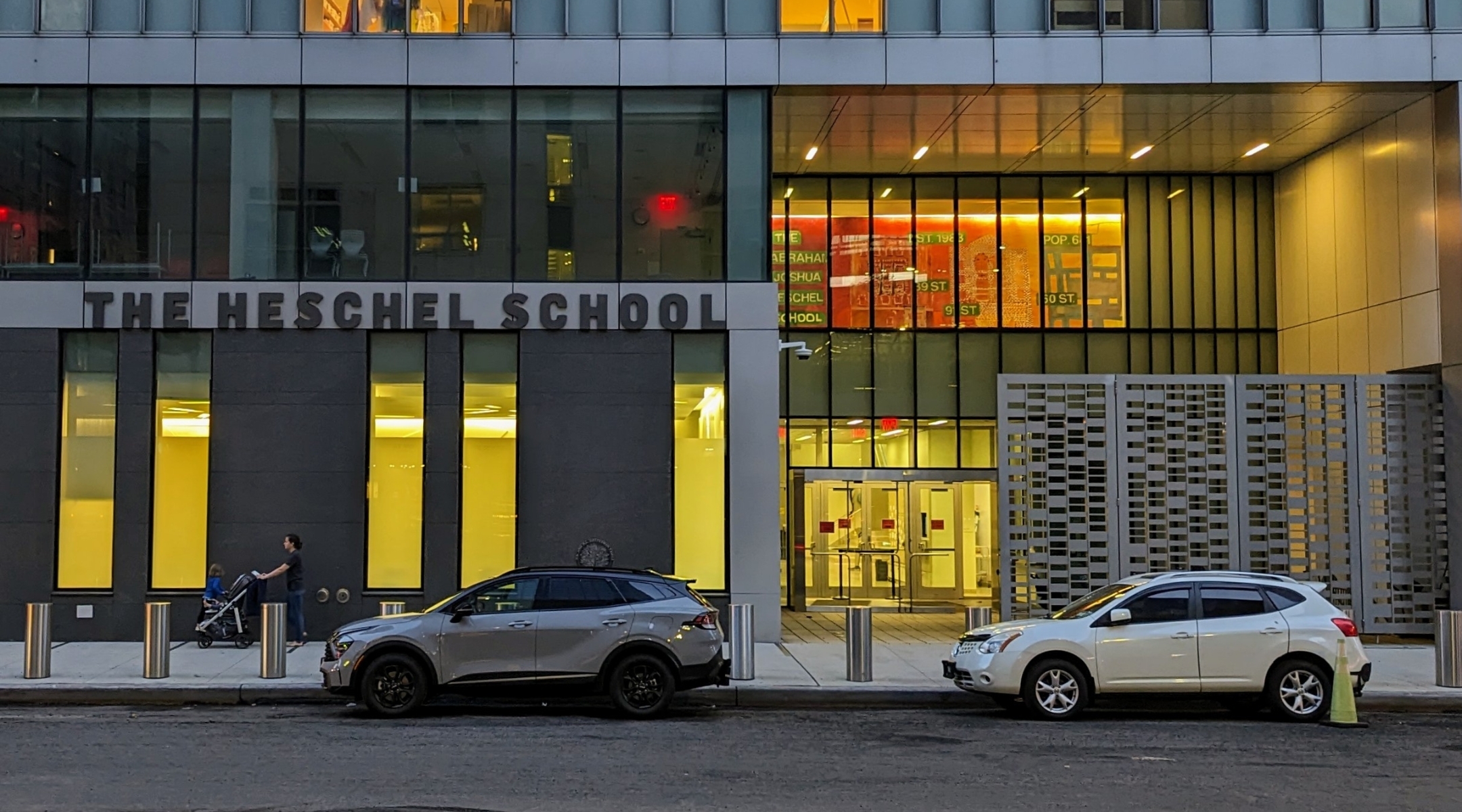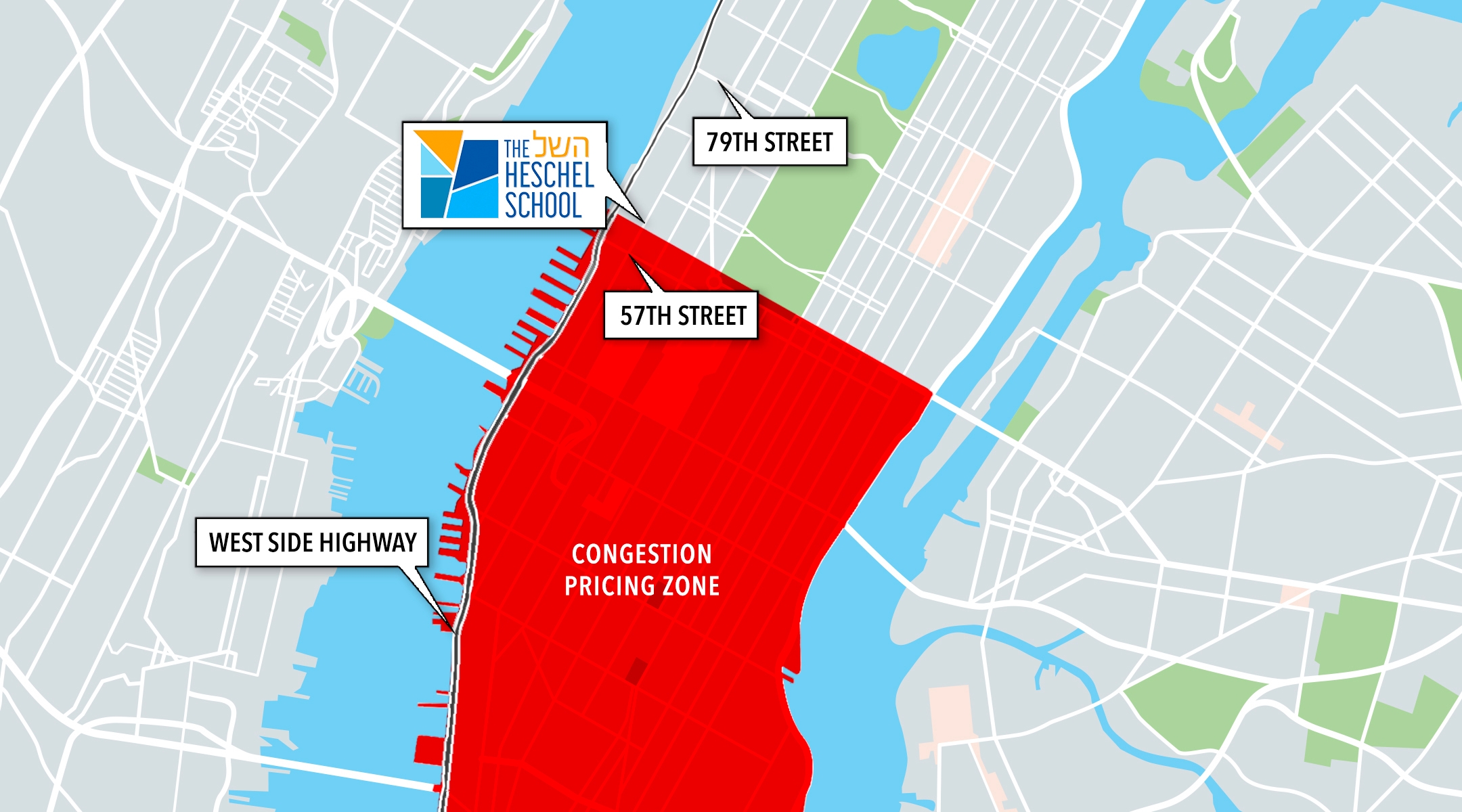Noah Allen, the father of a fourth grader, typically sends his daughter to and from the Abraham Joshua Heschel School on a bus.
But twice a week, he drives her to the Upper West Side school so she can attend early morning choir practice; occasionally, he attends prayer services at the pluralistic Jewish day school when parents are invited.
“We have tried to make it a priority to go to those things,” said Allen, who lives in Washington Heights, adding that the congestion pricing tolls that went into effect this week “will definitely change our plan on how to get to Heschel.”
Heschel sits between 60th and 61st Streets on West End Avenue — right at the cutoff of the Congestion Relief Zone along 60th Street. As of Sunday, Jan. 5, personal vehicles entering this zone pay a minimum toll of $2.25 overnight and a maximum of $9 during peak hours (which run from 5 a.m. to 9 p.m. on weekdays).
Charging vehicles to enter New York City’s central business district has been a policy project many years in the making, and is intended to reduce the number of cars coming into Manhattan and finance the city’s public transit system — which many Heschel families use to get to school
But for families and teachers at the school who live further uptown, in the outer boroughs or in the suburbs, the new toll — which is slated to reach $15 by 2031 — has prompted a rethink of their regular commute.

Exterior view of the Heschel School in Manhattan. (Wikimedia)
Allen’s route is a case in point: Previously, he would typically drive south along the West Side Highway and exit at 57th street. But now that commute incurs a $9 toll, so Allen tried something new on Wednesday: exiting the highway 22 blocks north at 79th street. The new drive, which took him on local streets instead of continuing on the highway, added a few minutes to the journey. He parked a few blocks north of the congestion pricing zone.
“It’s not as, quote, ‘simple’ as it had been,” Allen said. “For the most part, I think [this] is going to be our new plan.”
Mike Boxer, a member of the Jewish a cappella group Six13 and a Heschel parent living in Forest Hills, is also rethinking the drop-off and pick-up process for his two kids. (In 2021, a chain link fence near the school served as the setting for Six13’s “West Side Story”-themed Hanukkah parody song.)
“The congestion pricing definitely does affect us,” Boxer said.
Boxer has an 11-year-old daughter and a 10-year-old son at Heschel, and also works in Battery Park, which is within the congestion pricing zone. Before this week, he typically drove the kids to school by entering Manhattan via either the Queens-Midtown Tunnel, which deposits cars in Manhattan through either East 37th or East 35th, or the 59th Street Bridge. He would then continue downtown to his office.
Now, both of those options would incur congestion fees. The only way to fully avoid the congestion fee would be to take the Triborough Bridge, Boxer said, “which would add a ton of time for us.” (Plus, the Triborough Bridge has long carried a toll, which is currently $6.94 for drivers with E-Z Pass.)
“It’s just been such a confusing situation that it’s almost not worth trying to avoid that extra $6 or $9 whatever it may wind up being,” Boxer said. “So it’s just an added expense.”
But Heschel was something of a special case, he acknowledged.
“That said, a lot of families at the Heschel School are fairly affluent, and I don’t know if they necessarily feel the burn of that additional expense every month,” he said. “Even if you’re doing it every day, 20 days a month, $180 a month may not necessarily hit you that hard.”
For Rachel Kleinbart, whose daughter is in second grade at Heschel, congestion pricing is not a factor for the school commute. She does not have a car; her daughter takes the bus from Washington Heights to school, and on rare occasions, they take the subway.
“I don’t think it’s affecting us in any way,” Kleinbart said. “Do I know families in the neighborhood who have cars, and do have kids who go to Heschel and sometimes have to be there early so they can’t take the bus? Yes. So I have some compassion for that. But we also just have the A train. So I don’t think it’s a huge deal.”
Though Friday marks the first full work week that congestion pricing has been in place — and experts warn it is too early to call the program a sweeping success — there are early signs that the program is reducing traffic in Manhattan, just as it was intended to. According to Gothamist, some New Yorkers living near the edge of the congestion zone have noticed a difference. “It was just hard to see the walk sign, because people [in cars] were in the intersections,” East Sider Susan McManus told the publication. “I can cross across the avenue without there being gridlock.”
Allen said his family may begin to use the subway more frequently to get to school. Though the subway stop is not far from their home, it is a nearly 15 minute walk to the A train from the school — and a steep uphill trek.
“I think congestion pricing on paper is a good concept and is probably needed, but I think it’s going to take significant time to actually see an impact for everybody,” Allen said. “It’s not like all of a sudden, they flip the switch and the subways are more efficient, and more buses. It’s going to take time to get that money into the system.”
Boxer sees congestion pricing as yet another expense of living in New York City, where he said he’s been paying for tolls and parking for years.
“I have been trying to get to a place where it’s like, ‘Hey, some mornings, guys, let’s take the subway,’” Boxer said. “So this may light a little bit more of a fire under me. So maybe, a couple of days a week, we will take mass transit.”
The New York Jewish Week brings you the stories behind the headlines, keeping you connected to Jewish life in New York. Help sustain the reporting you trust by donating today.





